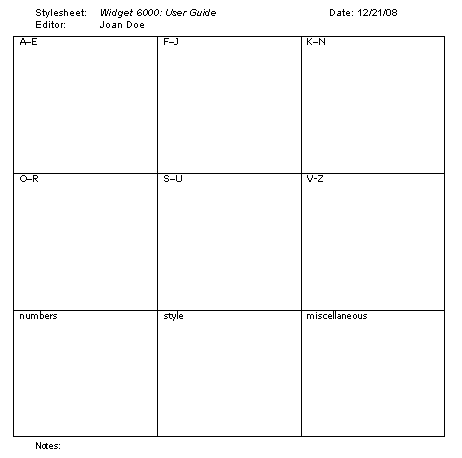Style Sheets
Copyeditors commonly keep a stylesheet for an individual document that they are editing. Stylesheets are the copyeditors' notes on all the "calls"—the editorial judgment calls—that they have to make during an edit.
When you copyedit, you'll often find that there are multiple correct ways of doing things. You can look out in standard professionally edited documents and see these multiple and conflicting practices. Here are some examples:
Symbols, abbreviations, or fully written-out words for measurements? ", in., or inch?
The word "to" or "through" or a dash between ranges of numbers in regular text?
The abbreviation "No." or "no." or # or nothing on numbered things like Site 1?
Numbers and measurement words written solid or separate: 35m or 35 m?
Is it US or U.S.; is it AM or am or a.m.?
Use x or "by" in this like 2x4 or 1024 by 768?
When there is no obvious standard for an editorial problem, you have to make a decision. To ensure that you remember that decision and that other editors can apply it, keep a stylesheet. To make the decision, check for "trends" in similar documents of your organization, industry, or field. An editorial "trend" is simply usage or practice that seems the most common. Of course, some organizations have their own house style; some industries and fields have their style guides. You'll read about style guides elsewhere. If these exist, check them first.
If you still must make the editorial call, attempt to make that call in such a way that it is consistent with the rest of the style in your documents. For example, imagine that the documents you edit write out measurement names such as "foot" and "inch." On a particular edit, you must decide whether to use #. Because you are not using symbols for foot and inch, don't use this symbol either.
To keep a stylesheet, use a format similar to what you see here:

There is no required or standard format for stylesheets. Construct your stylesheets according to whatever works best for the documents you edit. For example, if you are editing a large document, you may want fewer letters in each block. At the bottom, you may want a block strictly for punctuation or strictly for symbols and abbreviations.
What should you record in your stylesheet and how? Here are some recommendations:
- Include all hyphenated compounds. After the ones that function as adjectives, write (adj); after the ones that function as verbs, (v).
- All compound words for which there might be doubt or debate: for example, wastewater.
- All abbreviations: U.S. or US?
- All formal names, especially those that might be handled incorrectly: Photoshop? Photo Shop? University of Arizona or Arizona University?
- All capitalized or noncapitalized words for which there might be any doubt: for example, Internet.
The non-letter blocks at the bottom of a stylesheet deserve some special comment:
- State special rules as succinctly as possible: for example, Use "to" not dash (3 to 8 gallons)
- Don't go overboard and state rules that are commonly found in any standard grammar-usage handbook.
- Include your editorial calls on punctuation: for example, Use periods on list items only if complete sentences.
- Include your editorial calls on capitalization: for example, Use sentence-style caps on all list items.
These recommendations by no means exhaust the possibilities. Remember the fundamental reason for keeping a stylesheet: so that you and other editors can stay consistent on your editorial judgement calls—especially when months pass between edits of the same document.
Remember too that the document you edit may be nicely consistent in certain areas. For example, it may be quite consistent on its handling of abbreviations. You still need to represent that usage in your style sheet (stylesheet needs to be in my stylesheet!) in some way—whether it is in the letter blocks, the usage blocks at the bottom, or both.
Here is an excerpt from a stylesheet:

Programs and information provided by admin@mcmassociates.io.